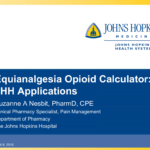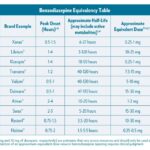Johns Hopkins Opioid Equivalency Table (Download)

Opioids are an important tool in the management of acute and chronic (cancer and non-cancer) pain. Pain and palliative care practitioners are frequently called upon to switch a patient from one opioid regimen to a different regimen either to gain better pain control, to minimize opioid-related adverse effects, to overcome opioid tolerance, or due to a change in patient status. To this end, equianalgesic tables like the Johns Hopkins have been published to guide practitioners in making these calculations. Download Here
Here’s a basic opioid equivalence table:
| Current Opioid | Equianalgesic Dose (mg) | New Opioid |
|---|---|---|
| Morphine | 10 mg | Oxycodone |
| Oxycodone | 20 mg | Hydrocodone |
| Hydromorphone | 1.5 mg | Fentanyl |
| Fentanyl | 0.1 mg | Methadone |
| Methadone | 10 mg | Morphine |
| Codeine | 120 mg | Oxycodone |
| Hydrocodone | 30 mg | Hydromorphone |
| Meperidine | 75 mg | Morphine |
| Buprenorphine | 0.8 mg | Morphine |
| Tramadol | 100 mg | Morphine |
| Tapentadol | 75 mg | Morphine |
| Levorphanol | 4 mg | Morphine |
| Pentazocine | 30 mg | Morphine |
| Nalbuphine | 10 mg | Morphine |
| Butorphanol | 2 mg | Morphine |
| Oxymorphone | 1 mg | Morphine |
| Dezocine | 15 mg | Morphine |
| Sufentanil | 0.005 mg | Fentanyl |
| Remifentanil | 0.1 mg | Fentanyl |
| Alfentanil | 0.02 mg | Fentanyl |
Remember that this table provides approximate equivalence values and should not replace professional medical advice. Always consult a healthcare provider and use reliable sources for opioid conversion calculations, especially when dealing with patient care.
You may find useful information on: Best Online Opioid Conversion Calculators





